A few weeks ago, I wrote about my top 3 favorite artists.
Alphonse Mucha was one of them. He’s actually my second favorite artist after Waterhouse.
If you’re an artist, you should have your favorites. I emphasize the word “favorites” (plural) because if you only have one favorite artist, you run the risk of your works looking too much like him or her.
Heck, go to an art gallery or you can even do an online search. Too many artists nowadays have no originality whatsoever. I’ve seen countless artists who look just like everyone else. That’s because they haven’t done their homework. They haven’t studied enough artists, other than their limited circle.
It’s the same thing with music. When we played shows with other bands, we’d watch their shows. You could always tell when someone didn’t have enough influences. They would sound way too much like their favorite band.
It’s also good to have a wide variety of influences. My top three artists alone cover three distinct art styles – Pre-Raphaelites (a subset of Romanticism), Art Nouveau, and American Fantasy/Sci-Fi.
So let’s talk about Alphonse Mucha, my second favorite artist.
Short bio of Mucha
Alphonse Mucha was born on July 24, 1860 in the Austrian Empire (present day Czech Republic). He was a Czech artist living in Paris.
As a young man, Mucha was very religious. He sang at church and also played violin.
He studied in both Munich and Paris. In Paris, he studied under both Jules Lefebvre and Jean-Paul Laurens, the former of whom I’m a big fan of.
Mucha became popular for his Art Nouveau art, mainly for making theatrical posters and advertisements. His career exploded after the celebrity theater actress Sarah Bernhardt strongly promoted his works.
Mucha rose to become one of the most, if not the most, well-known Art Nouveau artists.
In the early 20th century, he moved to America where he met Charles Richard Crane, who became his main patron. Crane shared his Slavic Nationalism. When Mucha went on to design the Czechoslovakian bills, he used Crane’s daughter as the model for the 100 koruna bill.
Mucha eventually succeeded as a Slavic Nationalistic artist. He wanted to be known more for his Slav Epic than for his earlier Art Nouveau works.
With all due respect for his later works (yes, they were quite good), I like him for his earlier Art Nouveau works, which were a huge influence on me.
In the last year of his life, the Nazis invaded Czechoslovakia. Mucha was already known as a Slav Nationalist so he was detained and interrogated. They released him as his health was already failing and he died shortly before the outbreak of WWII.
Mucha’s Art Nouveau vs Mucha’s Slavic Nationalism
Unfortunately for Mucha, his Slavic Nationalistic works didn’t receive that much attention in his lifetime and the world knew him for his Art Nouveau works. He didn’t even like Art Nouveau. From what I’ve read about Mucha, I’m guessing he did that style for the money and his true passion was to be a Slavic historical painter.
One other little tidbit that you won’t hear too many art historians talk about..
Mucha’s Art Nouveau is technically commercial art. His Slavic Nationalism is high art.
Does it matter?
It probably mattered to Mucha. Nowadays, the lines are blurred. Some of the top selling paintings of all-time are pop art. But to Mucha, he wanted to be seen as a historical, nationalistic painter. Not just a guy who does commercial art.
As much as I can appreciate his later works, I’m heavily influenced by his Mucha Girls, which were done during his Art Nouveau period.
Mucha Girls
Search engines have several major problems. One serious problem – accuracy.
I do a search for “Mucha Girls,” trying to get a little bit more historical background on the actual name, and I get a band called “Mocha Girls.”
Also, folks who are good at SEO tend to get their bullshit propping up to the top of the results, despite how actually helpful it is. Half of the articles I found on Mucha Girls didn’t help much. But apparently, they were good at SEO.
So, I actually can’t tell you if the term “Mucha Girls” appeared in his lifetime or afterwards.
I do own an excellent coffee table book by Rosalind Ormiston called Alphonse Mucha Masterworks. In it, Ormiston mentioned “Le Style Mucha” many times, a term that did appear in Mucha’s lifetime.
Regardless, I’m going to use the modern term Mucha Girls to refer to Mucha’s subjects.
Historically, Mucha was barely scraping by in Paris until Sarah Bernhardt started promoting his works.
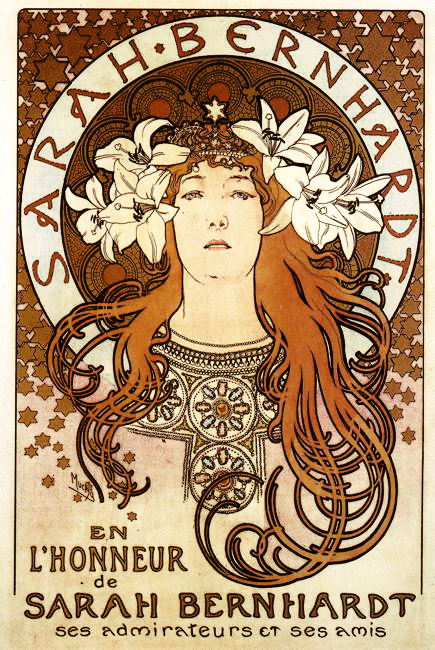
Bernhardt wasn’t the first Mucha Girl. Just the one who helped put him on the map.
Soon afterwards, Mucha became a hot commodity.
The demand for his products soon started outpacing the supply and Mucha ended up moving to America to pursue his true dream of producing historical Slavic art.
We’ll focus on Paris though because that’s where he painted his Mucha Girls.
Companies varying from cigarette companies to champagne to bicycle companies all wanted his artwork on their advertisements. The featured image (the image at the top of this article) is an Absinthe ad.
I won’t go through all the advertisements he did with beautiful women. I will however show you some of my favorites.
Maude Adams as Joan of Arc
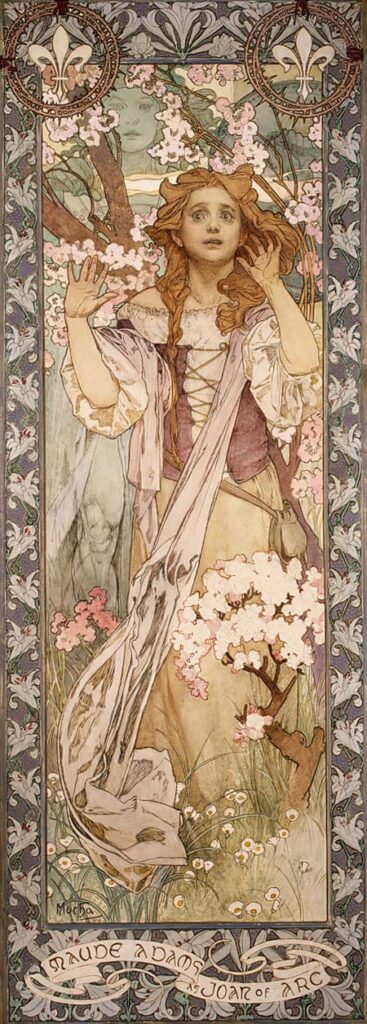
Have you ever seen the Peter Pan play? Unfortunately, I never have.
Here’s Maude Adams, an early 20th century celebrity. Best known for her role as Peter Pan (yes, Peter Pan was usually played by a girl in the play).
Mucha had a great command of emotion. Not just an artist who painted beautiful women. (Not that that’s a bad thing of course).
And of course, you can see who I stole my hair from. The way I paint my hair is straight up stolen from Mucha.
I love the way he makes her hair flow. It looks so alive. So real.
That’s one commonality of the Art Nouveau period. They idolized nature and tried to incorporate as many organic lines as possible.
So hair flowed like vines. Plus, they had either vines or vine-like lines throughout their works. Even in their architecture.
You could also tell that Mucha loves flowers. I can’t speak for Mucha but I love the opportunity to add more colors into my paintings. Flowers are a great excuse to add more color. After all, what has better color than some lovely flowers?
If you’re an artist by the way, give credit where it’s due. It’s honest, and it’s honorable.
If you take a technique or you’re heavily influenced by someone, say it. It gives you more credibility too. I once had an artist tell me that she didn’t have any influences. I immediately lost any interest whatsoever in her art.
Salon des Cent (1896)
To this day, I’m kicking myself.
I had a chance to buy a lithograph of Mucha. Yes, a real certified one. I think it might have been this one.
Rather, I spent that money on cryptocurrency because I was convinced that would make me enough money to buy several Mucha lithographs.
Well, we all know how that turned out. Oops.
Note the hair. Once again, if you know my work, you can see how influenced I was by Mucha.
I require my models to have long hair. Long hair can do things like this and it’s a pivotal part of my work.
Also note the quill pen and the paintbrush. The feather of the quill especially. Those lines give the painting so much more life and they compliment her hair too.
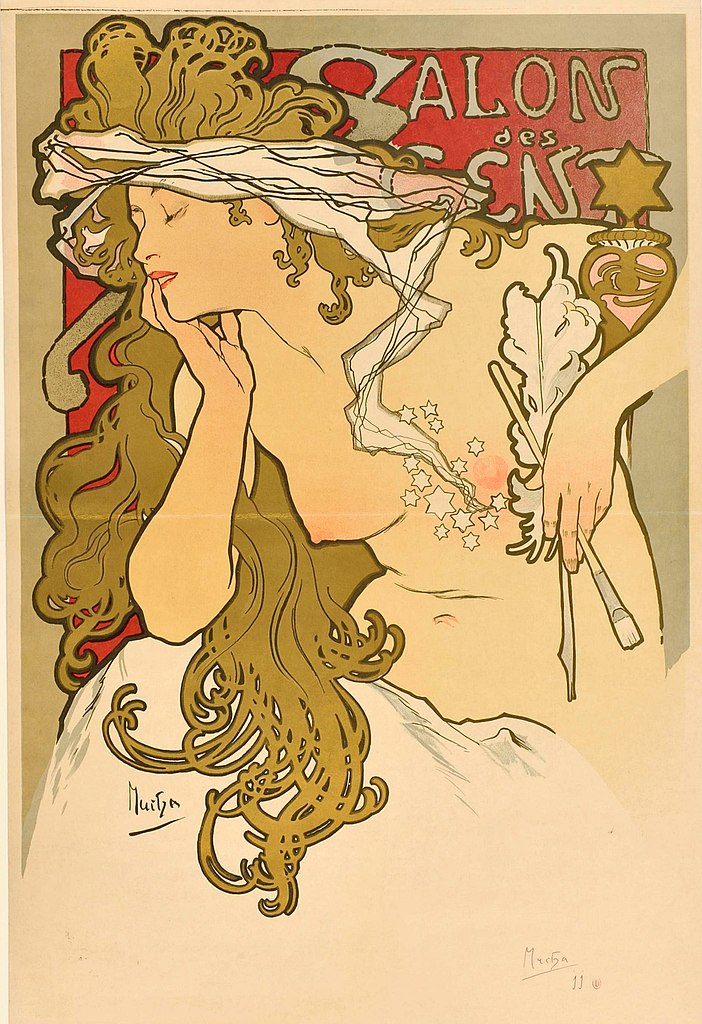
Tête byzantine
From 1897, we have Tête byzantine blonde and Tête byzantine brunette. Two lovely pieces.
Which reminds me – I’d love to do more pieces with some kind of hair decorations. Those were common fashion in the 1890s.


Tête byzantine (brunette)
One other thing to notice..
Notice how “soft” Mucha paints their skin. They look so soft, delicate. So feminine.
So easy to fall in love with these Mucha Girls.
Also note the ornamentation. The ancient Romans used a lot of ornamentation in their artwork as well.
In the end of the 15th century, Emperor Nero’s Domus Aurea got rediscovered by complete accident. This led to Renaissance painters picking up some of the grotesque* ornamentation that the Ancient Romans used.
Well centuries later, Art Nouveau artists had their own style of ornamentation, usually more natural looking. These ones are exceptions as they look quite different from the other ornamentation Mucha used in his other works.
And last, note that both girls’ hair flows all the way out of the circle. If you really want to emphasize long hair, that’s one way to do it!
Vin des Incas
My coffee table book luckily has a two-pager of this image. This digital picture doesn’t do it justice. At all. The two-pager is so much better looking.
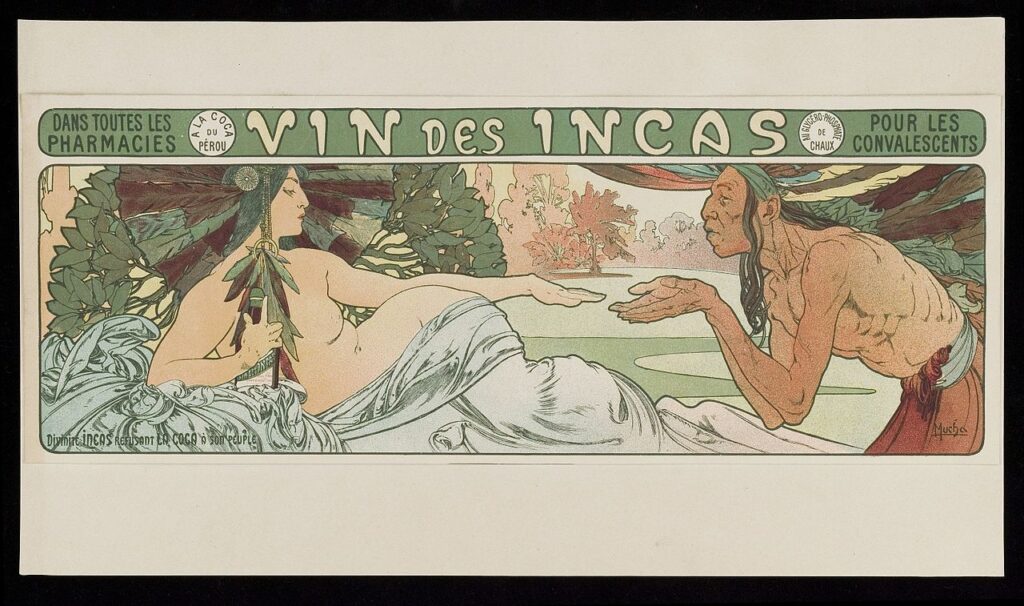
I don’t speak French but it’s close enough to Spanish that I’m guessing that’s Wine of the Incas and it’s some kind of pharmaceutical drug.
Note her hips.
Her curves.
Her face.
Her arms.
So feminine. Mucha reached the apex of feminine women in these paintings. I don’t think any other artist ever touched Mucha Girls. Their beauty is what I’ve spent years on trying to match.
Summer (1896)
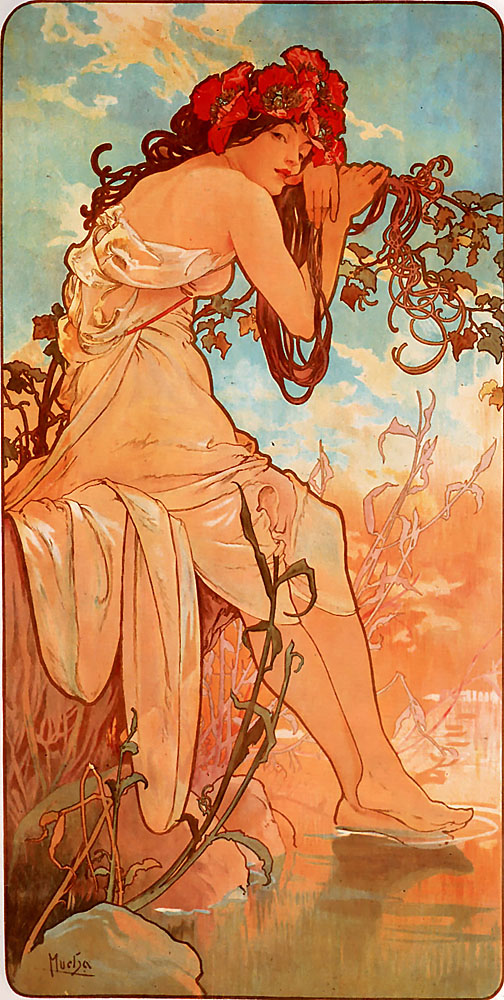
I love girl hands. And girl feet.
I’ve been trying to incorporate both into my paintings more.
When I hire a model, I look at her hands.
Bad hands? No job.
Same with feet. I’ve worked with models with bad feet before but I’ve never painted them.
I absolutely love the way Mucha does girl hands and girl feet.
And the flowers in her hair. That’s another thing that I stole from Mucha.
Although (to my knowledge) he never painted Antheia, Greek Goddess of Flowers, I use Antheia as an excuse to paint flowers in my model’s hair.
And notice how she looks at you. So lovely that I wish I had this painting up on one of my walls. Not a print, but the real thing.
Also, remember when I mentioned vines? This is a perfect example. You’ll see the vines and vine-like lines throughout this painting, which really give a secondary motion to the artwork.
There’s a lot going on, with each movement being intentional. You have the beautiful girl looking at you. You have the plants that almost look like they’re growing as we speak. And you have the otherwise calm water, slightly disturbed by the girl’s feet.
Even the clouds. Don’t they look like they can change at any moment?
Note too her dress, partially removed. Giving you a voyeuristic tease.
A great exercise for artists
I’d love to see other contemporary artists do this. Name your favorite artists. Then if you’re brave enough, state exactly how they influenced you.
You can even do a deep dive. Pick several of their pieces. Closely examine each piece. Look for every detail, no matter how insignificant. A mediocre artist fills his artwork with fluff. A good artist fills his artwork intentionally.
There is no fluff in a Mucha piece. Every piece looks like Mucha almost regrets running out of room.
It’s very hard for me to rank Waterhouse, Mucha, and Frazetta. All three of them influenced me in so many different ways.
I’ll eventually have to write an article for Waterhouse and Frazetta as well. I only started with this one because I just happened to have the Mucha coffee table book out, which gave me the idea to write this article.
Oh, and also if you’re an artist and you’re feeling shy about giving credit where it’s due, remember this quote from Pablo Picasso:
Lesser artists borrow; great artists steal
Pablo Picasso
My hot tip related to stealing – steal from so many others that everyone thinks you’re original.
In other words – do your homework.
—
- the term “grotesque” has changed over the years. Nowadays, it can range from strange to unnerving. The original term came from “grotto” because a young Italian man from the late 15th century fell into what he thought was a cave (thus “grotto”). It turned out to be Nero’s Domus Aurea. This re-discovery heavily influenced Italian Renaissance art.
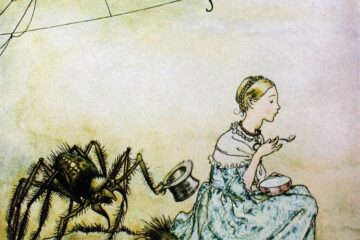
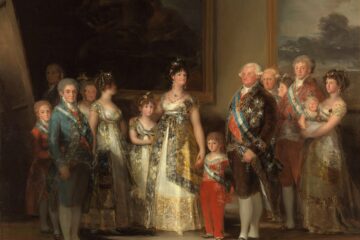
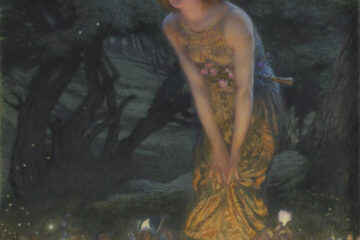
0 Comments